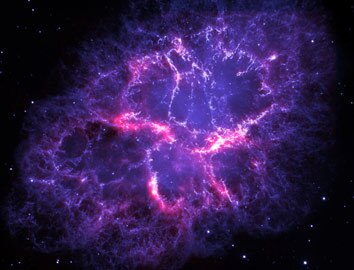Create a free profile to get unlimited access to exclusive videos, sweepstakes, and more!
Psychedelic Crab

The benefits of cleaning out your inbox: I somehow completely missed this spectacular image when it came out a while back, but now that I’ve found it I can share it!
Ye. Gads.
That’s the Crab Nebula, one of the most well-studied and famous objects in all the sky. It’s the expanding gas cloud left over from a titanic supernova explosion, in this case the death of a very massive star. The light from this explosion reached Earth in 1054, and in the subsequent millennium the debris has reached a size of well over 10 light-years.
That’s 100 trillion kilometers, just so’s you know.
This image combines observations from Hubble taken in visible light with far-infrared observations using the Herschel Observatory. Supernovae explosions combine huge temperatures with unbelievable pressures, enough that elements in the star undergo what’s called explosive nucleosynthesis: The blast actually fuses them together to make heavier elements. Cosmic alchemy!
Oxygen and sulfur in the debris glow fiercely in visible light. Hubble used three filters to pick those elements out, and those images were combined in the above photo and displayed as blue. Herschel is sensitive to dust: complex carbon-based molecules also created by the shock wave from the explosion. Those observations are colored red here. Where you see pinkish is where the nebula appears bright to both observatories.
I was also interested to see that Herschel had also taken spectra of the nebula, separating the light out into different wavelengths. When you do that you can measure various properties of the object observed, including its chemical composition. They found strong evidence in the spectra pointing at the presence of something truly weird: argon hydride.
Argon is a noble gas. The atoms of argon are configured in a way that it’s (in general) chemically inert; it won’t combine with other elements like carbon or oxygen do. Seeing it forming molecules is pretty strange. In this case, the argon in the nebula is zapped by fierce ultraviolet light from the central neutron star, the ultra-dense remnant of the core of the star that exploded. This rips electrons off the argon, making it easier for it to combine with other material in the gas.
Not only that, but elements come in different flavors called isotopes. They have the same chemical properties, but have fewer or more neutrons in their nucleus, changing the mass of the atom. This also changes the spectral properties of the light emitted. On Earth, the most common flavor of argon is argon-40, with 18 protons and 22 neutrons in its nucleus (made when radioactive potassium decays).
But the astronomers found argon-36 in the nebula, which only has 18 neutrons. That isotope is more common in space, and is created in the wave of supernova-driven nucleosynthesis. It makes sense they saw it in the Crab, even if it was a surprise it was in a molecular form.
Given that the Crab is big, nearby, bright, and so thoroughly scrutinized, I think it’s pretty cool that it still has a secret or two up its carapace. No matter how familiar we are with something, there is always more to discover.














